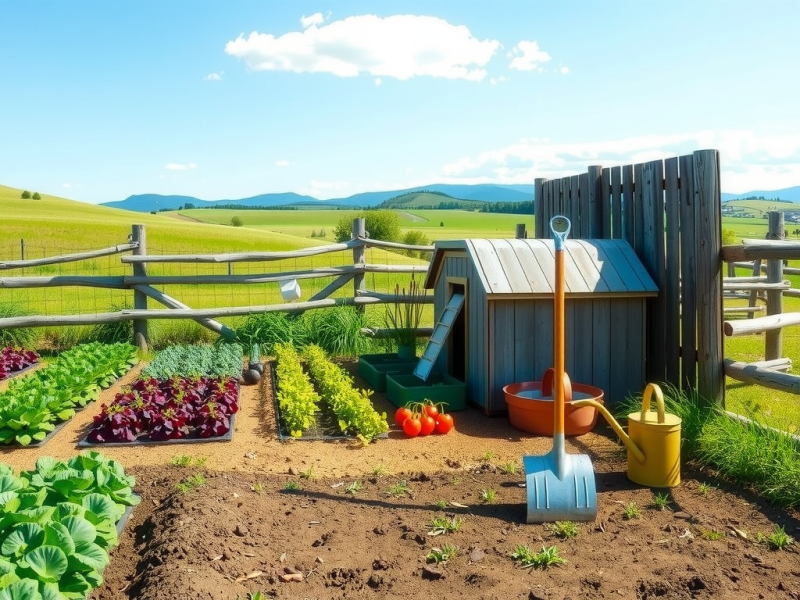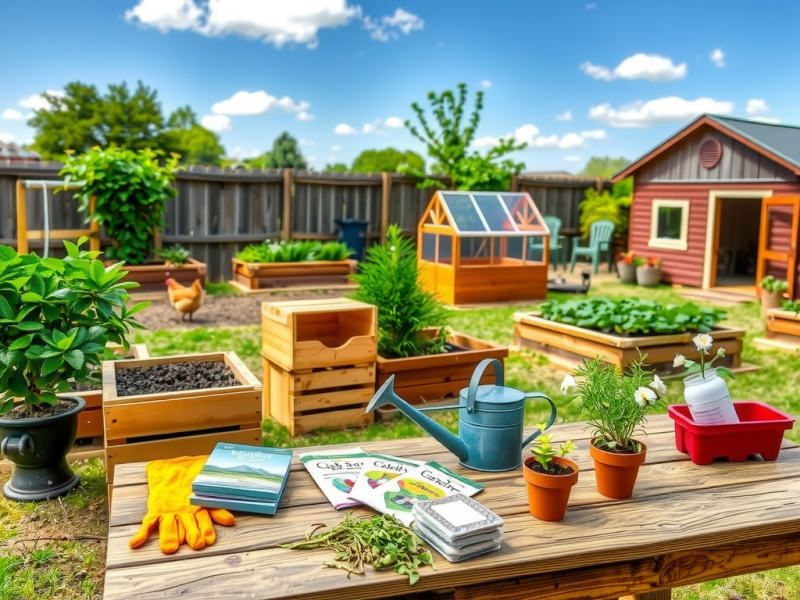Cover crops are one of the most powerful yet underutilized tools in a homesteader’s regenerative farming toolkit.
These hardworking plants grown not for harvest but to nourish and protect your soil can transform depleted earth into thriving, fertile ground while reducing your workload and input costs.
Whether you’re managing a small backyard garden or several acres, understanding cover cropping opens the door to healthier soil, better yields, and a more resilient homestead.
What Are Cover Crops and Why Should You Care?
Cover crops are fast-growing plants like legumes, grasses, or brassicas that you plant during fallow periods when your main crops aren’t growing.
Unlike cash crops grown for food or profit, cover crops serve as “green manure”—living soil amendments that protect and improve your land between growing seasons.
Think of cover crops as nature’s soil repair crew. While your garden beds rest, these plants are hard at work anchoring soil against erosion, cycling nutrients, suppressing weeds, and feeding the underground ecosystem of beneficial microbes and earthworms that make healthy soil possible.
The Multifaceted Benefits of Cover Cropping
Recent research from 2025 confirms what regenerative farmers have known for decades: cover crops deliver remarkable benefits that compound over time.
According to USDA surveys, farmers using cover crops experienced yield increases of 3.1% for corn and 4.3% for soybeans, attributed to improved soil health and resource efficiency.
Soil Health and Fertility Enhancement
Cover crops build soil organic matter—the foundation of soil fertility. When you incorporate cover crop biomass into your soil, you’re feeding billions of microorganisms that break down organic material and make nutrients available to your plants.
Studies show that maintaining cover crop biomass above 1,780 pounds per acre over multiple years consistently increases soil organic matter.
Leguminous cover crops like clover, hairy vetch, and field peas offer an additional superpower: nitrogen fixation. Through symbiotic relationships with Rhizobium bacteria in their root nodules, these plants capture atmospheric nitrogen and convert it into plant-available forms.
This biological nitrogen factory can contribute 50 to 200 pounds of nitrogen per acre—potentially replacing 30-60% of your synthetic fertilizer needs and saving you significant money.
Erosion Control and Water Management
Bare soil is vulnerable soil. Wind and water erosion can strip away precious topsoil in a single storm, taking decades of soil building with it.
Cover crops create a protective living blanket that anchors soil particles with extensive root systems while their foliage shields the surface from pounding rain and drying winds.
The benefits extend below ground too. Cover crop roots create channels that improve water infiltration—some species like daikon radishes can increase infiltration rates by up to 150%.
This enhanced soil structure helps your land absorb and retain moisture during droughts while preventing waterlogging during heavy rains. Research from California’s water-scarce regions demonstrates that properly managed cover crops can optimize water use to match bare soil levels while significantly increasing the soil’s water-holding capacity.
Natural Pest and Weed Management
Cover crops are your allies in the ongoing battle against weeds and pests. Dense cover crop canopies compete with weeds for sunlight, water, and nutrients, suppressing their germination and growth.
Studies show that achieving biomass levels above 4,460 pounds per acre provides significant weed reduction—potentially eliminating the need for herbicides in many situations.
Certain cover crops offer even more targeted benefits. Brassicas like mustards and radishes release natural compounds called glucosinolates that suppress soil-borne diseases and nematodes.
Meanwhile, flowering cover crops like crimson clover and buckwheat attract beneficial insects—pollinators, predatory wasps, and ground beetles—that help control pest populations naturally.
Economic and Environmental Returns
While there’s an upfront cost to cover crop seed and establishment, the return on investment often exceeds expectations. Beyond the yield increases mentioned earlier, cover crops reduce your need for:
- Synthetic fertilizers (especially nitrogen)
- Herbicides for weed control
- Irrigation water
- Tillage and fuel costs
For livestock operations, cover crops can double as forage, providing nutritious grazing that diversifies income while the animals’ hooves and manure further enhance soil health.
The environmental benefits—carbon sequestration, reduced nutrient runoff, enhanced biodiversity—contribute to a more sustainable and resilient farming system that can weather climate extremes.
Choosing Your First Cover Crops: A Beginner’s Guide
The key to cover crop success is matching the right species to your goals, climate, and soil conditions. As a beginner, start simple with one or two proven species rather than complex mixtures. Here are the top cover crops for beginners, organized by their primary benefits:
Best Cover Crops for Nitrogen Fixation
Crimson Clover (Trifolium incarnatum)
This beautiful legume with its distinctive red flower spikes is a favorite among homesteaders for good reason. Crimson clover can fix up to 120 pounds of nitrogen per acre while improving soil structure through its extensive root system. It’s relatively easy to establish, attracts pollinators, and suppresses weeds with its dense growth.
Best for: Mild winter regions, spring planting in colder areas
Planting rate: 15-25 lbs/acre (broadcast), 10-15 lbs/acre (drilled)
Termination: Mow before seed set or till under in spring
Hairy Vetch (Vicia villosa)
If you need serious nitrogen fixation, hairy vetch is your champion. This cold-hardy legume can contribute up to 200 pounds of nitrogen per acre and provides excellent winter cover that prevents erosion. Its vining growth habit makes it ideal for mixing with grasses that provide structural support.
Best for: Cold climates, overwintering
Planting rate: 20-40 lbs/acre (alone), 10-20 lbs/acre (in mix)
Termination: Mow or roll-crimp at flowering, before seed set
Austrian Winter Peas (Pisum sativum)
These cold-hardy peas fix 100-150 pounds of nitrogen per acre and establish quickly in fall. They’re particularly effective when mixed with cereal rye, which provides support for the vining peas while adding biomass for erosion control.
Best for: Fall planting, cold tolerance
Planting rate: 30-60 lbs/acre (alone), 20-40 lbs/acre (in mix)
Termination: Winter-kill in harsh climates, otherwise mow in spring
Best Cover Crops for Soil Structure and Erosion Control
Cereal Rye (Secale cereale)
Cereal rye is the workhorse of cover crops—hardy, reliable, and incredibly effective. It germinates in temperatures as low as 34°F, making it ideal for late fall planting when other options have passed. Its extensive fibrous root system breaks up compacted soil, improves water infiltration, and produces significant biomass for organic matter.
Cereal rye also has allelopathic properties—it releases natural compounds that suppress weed germination, giving your spring crops a head start. This makes it particularly valuable for organic growers.
Best for: Late fall planting, cold climates, weed suppression
Planting rate: 60-120 lbs/acre (broadcast), 50-90 lbs/acre (drilled)
Termination: Mow or till 2-3 weeks before planting cash crops
Oats (Avena sativa)
Oats are the perfect beginner cover crop because they’re forgiving, inexpensive, and winter-kill in most climates—meaning they naturally die back in freezing temperatures, eliminating the need for spring termination. Their fibrous roots improve soil structure and water infiltration while their biomass adds valuable organic matter.
Best for: Fall planting, beginner-friendly, winter-kill zones
Planting rate: 50-100 lbs/acre (broadcast), 40-80 lbs/acre (drilled)
Termination: Winter-kill (no action needed) or mow in spring
Daikon Radish (Raphanus sativus var. longipinnatus)
Also called tillage radish, this brassica is nature’s subsoiler. Its thick taproot can penetrate 2-3 feet deep, breaking up compacted hardpan layers and creating channels for water infiltration and future crop roots. When the radish winter-kills, it decomposes quickly, leaving behind improved soil structure and captured nutrients.
Best for: Compacted soils, fall planting
Planting rate: 8-12 lbs/acre (broadcast), 5-8 lbs/acre (drilled)
Termination: Winter-kill (decomposes naturally)
Best Cover Crops for Quick Growth and Weed Suppression
Buckwheat (Fagopyrum esculentum)
Buckwheat is the sprinter of cover crops, germinating in just 3-5 days and reaching maturity in 6-8 weeks. This makes it perfect for short windows between crops or for quick weed suppression in summer. It’s also excellent at scavenging phosphorus from the soil and making it available to subsequent crops.
As a bonus, buckwheat’s white flowers are a magnet for pollinators and beneficial insects, making it a valuable addition to any homestead ecosystem.
Best for: Summer planting, short growing windows, pollinator habitat
Planting rate: 50-70 lbs/acre (broadcast), 40-50 lbs/acre (drilled)
Termination: Mow before seed set or frost-kill
Planting Cover Crops: Timing, Methods, and Rates
Success with cover crops starts with proper timing and establishment. Most cover crops are planted in late summer or early fall after harvesting your main crops, giving them 4-6 weeks to establish before the first hard frost. However, timing varies by species and region.
Seasonal Planting Windows
Fall Planting (Most Common)
Late summer through early fall is prime time for cover crop establishment. In most regions, this means:
- Late August to mid-September: Ideal for winter-hardy species like cereal rye, hairy vetch, and winter peas
- Early to mid-September: Good for oats (if you want winter-kill) and crimson clover
- Late September to early October: Last chance for extremely hardy species like cereal rye
The key is allowing enough time for germination and establishment before cold weather arrives. In warmer climates, you can plant later; in colder regions, plant earlier.
Spring Planting
Spring cover crops work well in several situations:
- After early spring harvest of crops like spinach or lettuce
- In areas with harsh winters where fall establishment is difficult
- For warm-season species like buckwheat or cowpeas
Plant spring cover crops as soon as soil can be worked and temperatures are appropriate for your chosen species.
Planting Methods for Small-Scale Homesteads
Broadcasting by Hand
For small gardens and plots under an acre, hand broadcasting is simple and effective:
1. Prepare the seedbed by removing weeds and loosening the top inch of soil
2. Calculate your seed amount based on the area (convert lbs/acre to your plot size)
3. Divide seed into two equal portions
4. Walk the area in one direction, broadcasting the first half evenly
5. Walk perpendicular to your first pass, broadcasting the second half
6. Lightly rake to ensure seed-to-soil contact (critical for germination)
7. Water if rain isn’t expected within 48 hours
Using a Broadcast Spreader
For areas larger than a few hundred square feet, a hand-crank or push broadcast spreader saves time and ensures even distribution. Adjust the spreader settings based on seed size—larger seeds like peas need wider openings than tiny clover seeds.
No-Till Methods
If you’re practicing no-till gardening, you can establish cover crops by:
- Broadcasting seed onto crop residue or mulch
- Using a dibber or hoe to create shallow furrows for larger seeds
- Covering with a thin layer of compost or mulch
The key is ensuring good seed-to-soil contact, which may require heavier seeding rates (increase by 25-50%) to compensate for lower germination.
Seeding Rates and Seed Inoculation
Seeding rates vary by species, planting method, and whether you’re planting a single species or a mixture. The rates provided earlier are for pure stands; when mixing species, reduce each by 30-50% depending on the number of species in your mix.
Inoculating Legume Seeds
To maximize nitrogen fixation from legumes, inoculate your seeds with the appropriate Rhizobium bacteria before planting. This simple step can dramatically increase nitrogen production:
1. Purchase the correct inoculant for your legume species (different legumes need different bacteria strains)
2. Moisten seeds slightly with water or a sticking agent
3. Sprinkle inoculant powder over seeds and mix thoroughly
4. Plant immediately or within 24 hours
Inoculant is inexpensive (usually $5-15 per acre) and can be purchased from most seed suppliers. If you’ve grown the same legume in that field before, soil bacteria may already be present, but inoculation ensures optimal results.
Managing and Terminating Cover Crops
The final piece of the cover crop puzzle is knowing when and how to terminate them so they benefit rather than compete with your next crop.
Timing Your Termination
The ideal termination timing depends on your goals and the subsequent crop:
For Maximum Biomass and Nutrient Cycling
- Terminate at flowering or early seed set when biomass is highest
- This provides maximum organic matter and weed suppression
- Allow 2-3 weeks for decomposition before planting
For Nitrogen Release
- Terminate legumes at early flowering for optimal nitrogen availability
- Younger, more succulent growth decomposes faster and releases nitrogen sooner
- Older, woodier growth takes longer to break down
For Weed Suppression
- Terminate before seed set to prevent cover crops from becoming weeds
- This is especially important for species like cereal rye that can reseed aggressively
Termination Methods
Winter-Kill (Easiest for Beginners)
Species like oats, daikon radish, and field peas naturally die when temperatures drop below their cold tolerance threshold. This is the simplest termination method—nature does the work for you. The dead plant material acts as mulch, protecting soil through winter and decomposing in spring.
Mowing or Cutting
For annual cover crops, mowing at the right stage kills the plants and creates a mulch layer:
- Mow when plants are flowering but before seed set
- Cut as low as possible (2-3 inches)
- Leave residue on the surface as mulch or incorporate lightly
Tillage
Incorporating cover crops through tillage speeds decomposition and nutrient release:
- Till when soil is workable but not too wet
- Chop tall growth with a mower first for easier incorporation
- Wait 2-3 weeks before planting to allow decomposition
- Consider shallow tillage (4-6 inches) to preserve soil structure
Roller-Crimping (Advanced)
This no-till method uses a heavy roller with crimping bars to flatten and kill cover crops:
- Best for mature, flowering cover crops
- Creates a thick mulch mat that suppresses weeds
- Requires specialized equipment but preserves soil structure
- Ideal for organic no-till systems
Grazing (For Livestock Homesteads)
If you have chickens, goats, or other livestock, they can terminate cover crops while adding fertility through their manure:
- Use portable fencing to control grazing
- Move animals before they damage soil structure
- Particularly effective with oats, peas, and clovers
Cover Crop Mixtures: Taking It to the Next Level
Once you’re comfortable with single-species cover crops, mixtures (often called “cocktails”) offer enhanced benefits by combining the strengths of different plant families.
Simple Two-Species Mixes for Beginners
Cereal Rye + Hairy Vetch
This classic combination pairs nitrogen fixation with biomass production and weed suppression. The rye provides structure for the vining vetch while scavenging excess nutrients.
Mix ratio: 60 lbs/acre rye + 20 lbs/acre vetch
Best for: Fall planting, overwintering, maximum nitrogen
Oats + Field Peas
A beginner-friendly mix that winter-kills in most climates, eliminating spring termination. The oats support the peas while both contribute to soil health.
Mix ratio: 60 lbs/acre oats + 40 lbs/acre peas
Best for: Fall planting, winter-kill zones, easy management
Buckwheat + Crimson Clover
A summer mix that provides quick cover and pollinator habitat while building nitrogen for fall crops.
Mix ratio: 40 lbs/acre buckwheat + 15 lbs/acre clover
Best for: Summer planting, pollinator support, quick turnaround
Principles for Successful Mixtures
When designing your own mixes, follow these guidelines:
1. Combine different plant families (legume + grass + brassica) for complementary benefits
2. Match growth rates so faster species don’t outcompete slower ones
3. Consider root structures – mix deep-rooted with shallow-rooted species
4. Adjust seeding rates – reduce each species by 30-50% from pure stand rates
5. Plan termination – ensure all species can be terminated at the same time
Common Mistakes and How to Avoid Them
Learning from others’ mistakes saves time and money. Here are the most common cover crop pitfalls and how to sidestep them:
Planting Too Late
Cover crops need time to establish before winter. Planting too late results in poor germination, minimal biomass, and wasted seed. Solution: Mark your calendar for planting dates 6-8 weeks before your first expected frost.
Poor Seed-to-Soil Contact
Broadcasting seed on hard, clumpy soil leads to poor germination. Solution: Always prepare a seedbed and rake or roll after broadcasting to ensure contact.
Terminating Too Early or Too Late
Terminating before adequate biomass develops wastes the cover crop’s potential. Terminating too late can lead to reseeding or nutrient tie-up. Solution: Monitor growth stages and terminate at early flowering for most species.
Not Inoculating Legumes
Skipping inoculation means missing out on nitrogen fixation—the main reason to plant legumes. Solution: Always inoculate legume seeds, even if you’ve grown them before. It’s cheap insurance.
Ignoring Allelopathic Effects
Some cover crops (especially cereal rye) release compounds that can inhibit germination of small-seeded crops. Solution: Allow 2-3 weeks between termination and planting sensitive crops like lettuce or carrots.
Planting the Same Cover Crop Repeatedly
Diversity is key to soil health. Rotating cover crop families prevents pest and disease buildup. Solution: Alternate between legumes, grasses, and brassicas in your cover crop rotation.
Getting Started: Your First Cover Crop Season
Ready to begin? Here’s a simple action plan for your first cover crop experience:
Step 1: Start Small
Choose one bed or a small area (100-500 square feet) for your first attempt. This allows you to learn without overwhelming yourself or risking your entire garden.
Step 2: Choose One Simple Species
For fall planting, oats are ideal for beginners—they’re forgiving, inexpensive, and winter-kill naturally. For spring, try buckwheat for its rapid growth and easy management.
Step 3: Calculate Your Seed Needs
Measure your area and calculate seed requirements. For a 500 square foot plot (about 1/87th of an acre):
- Oats: 0.5-1 lb of seed
- Buckwheat: 0.5-0.8 lb of seed
Step 4: Prepare and Plant
Clear weeds, loosen the soil surface, broadcast your seed evenly, rake lightly, and water if needed.
Step 5: Observe and Learn
Watch how your cover crop grows. Note germination time, growth rate, and how it responds to weather. Take photos to document your progress.
Step 6: Terminate and Evaluate
Follow the termination guidelines for your chosen species. After termination, observe how the soil looks and feels compared to areas without cover crops.
The Long-Term Vision: Building Soil Year After Year
Cover cropping isn’t a one-time fix—it’s a long-term investment in your soil’s health and your homestead’s productivity. The benefits compound over time as organic matter accumulates, soil structure improves, and beneficial organisms multiply.
Many experienced homesteaders aim to keep their soil covered year-round, rotating between cash crops and cover crops in a continuous cycle. This approach mimics natural ecosystems where bare soil is rare, and the result is soil that becomes more fertile, resilient, and productive with each passing season.
As you gain experience, you’ll develop an intuitive understanding of which cover crops work best in your specific conditions. You’ll learn to read your soil, adjust your timing, and fine-tune your mixtures. What starts as a simple experiment with oats or clover can evolve into a sophisticated system that dramatically reduces your input costs while increasing your yields.
The journey to healthy soil through cover cropping is one of the most rewarding aspects of regenerative homesteading. Each season brings new insights, and each cover crop contributes to the living legacy you’re building in your soil. Start simple, stay consistent, and watch as nature’s soil builders transform your homestead from the ground up.
—
Ready to take your homesteading journey further? Explore our comprehensive guides on composting, no-till gardening, and regenerative farming practices to build a truly sustainable homestead ecosystem.




